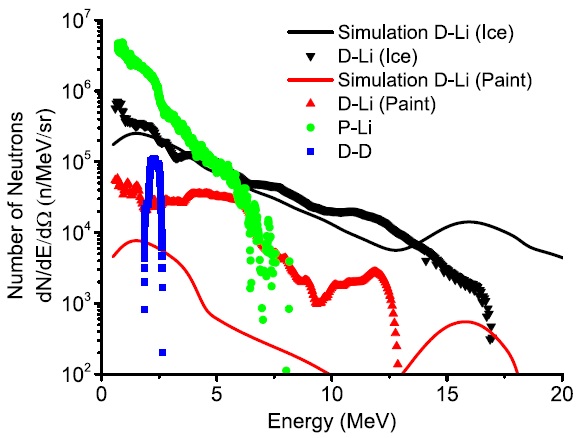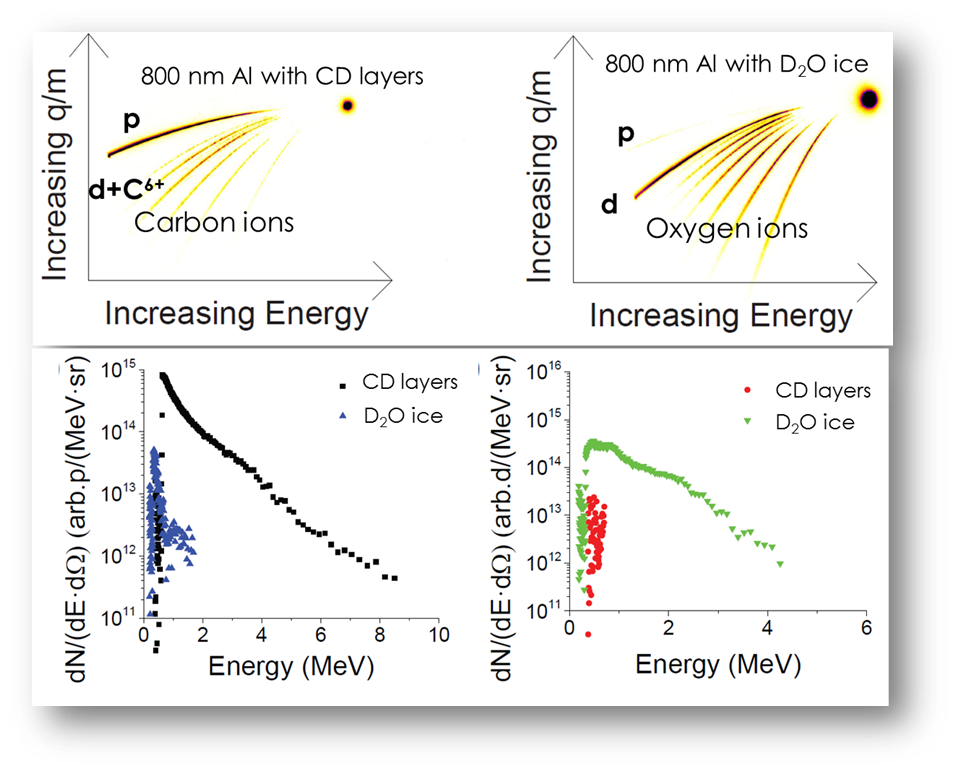Neutron beams with multi-MeV energies can be produced using laser based acceleration mechanisms in a two stage process whereby ions are accelerated and then converted into neutrons through nuclear reactions, as shown in Fig. 1. Fast neutron beams have applications in neutron radiography[1] imaging[2] and fast neutron therapy.[3] Compared to conventional accelerators, laser based techniques offer the advantage of reduced charged particle acceleration distances, from the meter scale to the millimeter scale due to the high electrical fields supported by plasmas, and high instantaneous neutron production rates, due to the short pulse duration of the laser and the corresponding short acceleration time.

Figure 1. Sketch of the target and catcher configuration used on the HERCULES laser. The laser pulse interacts with the front side of the foil (um thick Al or plastic) and accelerates ions from the rear surface, through target normal sheath acceleration, into the catcher.
Three nuclear reactions for neutron production were investigated on HERCULES, as listed in Table 1. The D-D reaction was investigated using bulk targets that were made from compressed deuterated polyethylene with a thickness of 1.5 (+/- 0.5) mm. The thick CD target was simultaneously a source of accelerated deuterons and target deuterons, both required for neutron production, which simplified the target configuration. Parylene 100 nm thin film targets were used to produce TNSA protons for the P-Li reaction in a pitcher-catcher configuration with an 0.85 cm thick LiF catcher. For deuteron reactions, the acceleration of deuterons required the introduction of a deuteron rich contaminant layer on the surface of the target which was accomplished through two methods. In one technique, developed by Willingale et. al. [4], denoted D-Li (Paint), 3 um Mylar targets were “painted” with a solution of deuterated polystyrene deposited on the rear surface with a thickness <1 um.

Table 1. Nuclear reactions and target configurations investigated on HERCULES. The highest measured flux was observed with for the P-Li reaction, and the highest energy was observed for the D-Li reaction using a cooled deuterated ice layer.
Alternatively, using an approach pioneered by Hou et al. [5] and further developed by Morrison et al. [6] and Maksimchuk et al [7], denoted D-Li (Ice), 800 nm Al targets were cryogenically cooled to allow D2O water vapor to freeze to the target front and rear surface, forming a deuteron rich contaminant “ice” layer which was proton free and dramatically enhanced the number of accelerated deuterons. Aluminum targets were selected for their high thermal conductivity.
Figure 2. . Ion spectra for Q/M = 1 (a) and Q/M = 1/2 (b) parabolas from sequential laser shots on 1.8 μm Al foil. (a) Proton spectra for the clean and ice covered target case showing suppression of the protons by the ice layer. (b) Q/M = 1/2 trace showing a small amount of C6+ contaminant for the clean case. The ice case shows no O7+ which precludes the presence of O8+ contamination in the trace, as well as no carbon traces, yielding a pure deuteron signal. The corresponding Thomson parabola traces for the clean (c) and ice (d) case demonstrate the dramatic increase in deuteron signal. Additionally, the heavy ion traces change from carbon (c) to oxygen (d). The dashed lines indicate the location of the proton and Q/M = 1/2 parabolas.

Figure 3. Experimental spectra from the four reactions. Monte Carlo simulated neutron spectra are shown for comparison.
The production of neutrons through charged particle acceleration and nuclear reactions at an intensity of 2 x 1021 W/cm2 was demonstrated on the HERCULES femtosecond laser system with a 0.1 Hz repetition rate (Fig. 3) [8]. The P-Li reaction demonstrated the highest directionality, 6.2( +/- 3.7) times higher in the forward direction than at 90o, due to the high initial proton energy achieved with the Parylene 100 nm target. The cryogenically cooled D-Li (Ice) target produced the highest energy neutrons in the ED+Q peak. The D-Li (Ice) target, of which 95% of the accelerated light ions were deuterons, improved both the energy and total number of deuterons and neutrons, as compared to the D-Li painted target. Both the P-Li and D-Li pitcher catcher targets produced higher neutron signals, both in energy and flux, than the D-D reaction, which was at attributable to the inferior acceleration of light ions in the thick target for the femtosecond pulse. The measured neutron flux from the HERCULES laser system is comparable to the flux produced by commercially available D-D generators but in a directional beam with a picosecond bunch duration. These results could also be scaled to higher repetition rates, as high intensity lasers that could produce 100 times the time averaged neutron flux of HERCULES are now becoming commercially available.
[1] L.J. Perkins, B. G. Logan, M. D. Rosen, M. D. Perry, T. Diaz de la Rubia, N.M. Ghoniem, T. Ditmire, P.T. Springer, and S.C. Wilks, Nucl. Fusion 40, 1 (2000).
[2] R. Loveman, J. Bendahan, T. Gozani, J Stevenson, Nucl. Instr. and Meth. in Phys. Res. B 99, 765 (1995).
[3] L.H. Gray and J. Read, Nature (London) 3845, 53 (1943).
[4] L. Willingale, G. M. Petrov, A. Maksimchuk, J. Davis, R. R. Freeman, A. S. Joglekar, T. Matsuoka, C.D. Murphy, V.M. Ovchinnikov, A.G.R. Thomas, et al., Phys. Plasmas 18, 083106 (2011).
[5] B. Hou, J.A. Nees, Z. He, G. Petrov, J. Davis, A.G.R. Thomas, and K. Krushelnick, Phys. Plasmas 4, 040702 (2011).
[6] J.T. Morrison, M. Storm, E. Chowdhury, K.U. Akli, S. Feldman, C. Willis, R.L. Daskalova, T. Growden, P. Berger, T. Ditmire, et al., Phys. Plasmas 19, 030707 (2012).
[7] A. Maksimchuk, A. Raymond, F. Yu, G. M. Petrov, F. Dollar, L. Willingale, C. Zulick, J. Davis, and K. Krushelnick, Appl. Phys. Lett. 102, 191117 (2013).
[8] C. Zulick, F. Dollar, V. Chvykov, J. Davis, G. Kalinchenko, A. Maksimchuk, G. M. Petrov, A. Raymond, A. G. R. Thomas, L. Willingale, V. Yanovsky, and K. Krushelnick, App. Phys. Let. 102, 124101 (2013).

